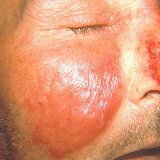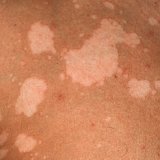Erysipelas: symptoms and treatment

erysipelas is a complex disease of the skin and mucous membranes. This infectious disease, which is characterized by the appearance of foci of acute serous inflammation on the skin, can be accompanied by fever and cause a general intoxication of the body. The disease can have a recurrent nature.
erysipelas is a very old disease, which was known many centuries ago and tried to treat it with folk methods, conspiracies and other things;It was described in the ancient writings of the Greek healers, who called it the "red skin disease".Previously, even before the emergence of medicine as such, the doctrine of the erysipelas and the methods of its elimination were being studied by such well-known scientists and thinkers as Celsius, Hippocrates, Galen and others. The next, no less significant contributions to the development of knowledge about the erysipelas were the works of Pirogov, who conducted an analogy with previous cases and studied it on the subject of the district hospital, where flashes of erysipelas were found.
What is the disease, what are its symptoms and treatment?
First of all it is worth recalling that erysipelas is an infectious disease. This causes common streptococcus group A. With the help of a variety of enzymes and toxins that are contained in this form of streptococcus, this disease is caused. Also, the source of the disease can be a person with various forms of diseases that are associated with streptococci, or a normal healthy person who is simply a carrier of streptococcus A. The disease has an airborne way of spreading, but no less popular way of spreading the disease is direct contact with a sick person. It can be through any wound that touches public things( handles on the door, for example), any crack on the skin, through the mucous membrane, or through sexual contact with a partner.
It can be said that catching erysipelas is very simple, even much easier than with influenza, especially if a person does not follow basic rules of hygiene and sanitation. Moreover, streptococci are resistant cells that continue to be "effective" for a long time after they have remained on common objects or other subjects that the patient has touched.
The propensity to a erysipelas can be even congenital, or to be shown in some people which organism is predisposed to such disease. It is likely that it is the individual predisposition of the disease that is determined far before human birth - at the genetic level. It is worth noting that women are more likely to become infected with the disease, most likely due to a more sensitive organism to infectious diseases and reduced protective properties of the body. Also, very often the erysipelas occur in people who previously had tonsillitis and are 8-9 times more likely to have tonsillitis than others. A variety of diseases of the mouth and teeth, multiple chronic diseases and complications can also accompany the spread of streptococci in the body, and as a consequence - erysipelas. Symptoms and treatment of erysipelas are somewhat problematic and long-term, and is due to this, a complex form of infectious disease, in which, first of all, its causative agent is eliminated.
Streptococci, and then erysipelas, can occur with localized foci at the site of postoperative scars, sutures, or in other places with skin disorders, so care must be taken to sanitize.
Treat the face with outpatient treatment, but very often hospitalization is prescribed, especially in cases of severe cases of erysipelas with subsequent complications. Also, elderly people and children are subject to hospitalization, for whom the course of erysipelas can be painful.
The incubation period of erysipelas is about 3-5 days and in most cases it starts rather sharply, therefore it is easy to notice even the hour of the onset of the disease, not to mention the day when the face showed itself. Symptoms of erysipelas are a strong increase in temperature, characterized by a very sharp, frequent pain immediately in the foci of erysipelas, and in some cases even vomiting in the patient, delusions and convulsions of the body can be observed. Also, the disease of erysipelas begins with the general aches in the body, the severity of movement and burning in the area of the appearance of erysipelas. On the second day after getting the infection in the patient's body there is a strong itch in the area of infection, which gradually becomes smaller with the immobility and calmness of the patient. Sometimes the disease is accompanied by severe pain of the lymph nodes and a headache.
Who is inclined to get sick with erysipelas and where does it come from?
Rogers often get sick early in the fall, or at the end of summer, when all diseases progress, thanks to the concomitant weather and favorable environment for the development of a variety of infections. Very inclined to the disease are people of construction professions, workers whose activities are associated with "hot" shops, as well as employees of a variety of refrigeration facilities and premises. The highest degree of disease of erysipelas is possessed by employees of coke and chemical plants, for which erysipelas infection has become a common thing.
It is important to point out that in our days, mostly serious forms of erysipelas are treated, at a time when, before 1980, there were almost no serious forms of this infectious disease. Statistics say that today more than 65% of patients have a moderate form of erysipelas, while 30% have a severe form and only 5% of all patients carry the entire period of the disease in mild form.
Prevention of erysipelas.
First of all, you need to observe hygiene, which in most cases is the main cause of all diseases. Proper treatment of wounds and timely treatment of a variety of purulent diseases will allow you to forever forget the word "erysipelas".Treatment of erysipelas is quite expensive and long, so do not neglect personal hygiene products and use elementary rules of conduct in possible foci of this disease. You also need constant monitoring of sick erysipelas, or for those who suffer from recurrent erysipelas. Supervision of patients can be carried out for two years after the disease.



